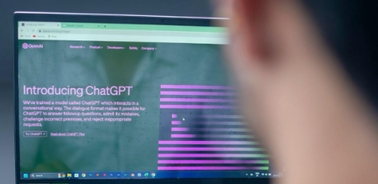Students in the Bachelor of Applied Mathematics Test ChatGPT

Students explored AI’s knowledge gaps in linear algebra and computer programming.
Students in the Bachelor of Applied Mathematics (BAM) worked to critique ChatGPT’s capability in generating a pythonic code that produces diagonalizable matrices with integer entries and integer eigenvalues.
Fifteen students from the Linear Algebra and Computer Programming courses had one month to answer questions about ChatGPT’s output and produce a report using LaTex, a widely used writing language that combines text and code in the scientific community. This task was proposed by Prof. David Gómez-Ullate, Academic Advisor of the students, since most diagonalization exercises include these type matrices that are not easy to find.
Daniel Precioso Garcelán, Computer Programming professor at the BAM said the best reports were those that recognized ChatGPT’s limits and demonstrated the learning process.
“The projects I enjoyed reading the most were the ones that showed all this learning process: starting with a code written by ChatGPT that barely accomplished the task, followed by many iterations where the team guided the AI until they got a polished and robust code,” Precioso explained.
The professor said he particularly enjoyed seeing when students asked ChatGPT to criticize its own answer.
“It is hilarious to see how the AI tries to defend mathematical concepts that are clearly wrong, and how quickly ChatGPT changes opinion when the students tell it that's not right!” Precioso said.
Margherita Tonon, a student in the BAM said she found it particularly important to see how weak AI’s mathematical reasoning is.
“AI tools do not yet have a deep-enough understanding of the concepts underlying mathematical formulas, and cannot always reason in slightly unfamiliar situations when they are asked to apply and utilize the true meaning behind formulas,” Tonon said. “The key takeaway from this project is possibly that the unique mathematical intuition that humans possess is crucial when problem solving and, for now, cannot be replaced by AI.”
Student Olivia Campsie said the project gave her insight as to how she would use ChatGPT in the future.
“I think that if I were to use it [ChatGPT], it would be as a base step. I think ChatGPT would be very helpful in providing starting suggestions such as summarizing information or providing a code to start with that can later be changed. It is a good way to generate first ideas,” Campsie explained.
Irene Alda, Academic Director of the BAM applauded the students’ performance in the project, highlighting the importance of understanding ChatGPT’s limitations and how it can help or not in solving any mathematical problem.
“I'm proud to see our students truly understand the concepts taught in class and find ChatGPT's knowledge gaps when answering a question,” Alda expressed.
She also emphasized other skills the project taught students.
“Knowing how to write in LaTex is a must for any applied mathematician,” she said. “Although there is a bit of a learning curve at the beginning, it is one of the best tools for writing a thesis, project, or any scientific document that is more than 2 pages long and includes formulas.”
But for many students, like Javier Benito, the key lesson was how to critically use and understand artificial intelligence as a resource.
“We should have a good overall view of the AI tool and check if it works correctly in the field we are working with and don’t suppose everything the AI returns to us is truly believable,” Javier Benito, BAM student said.